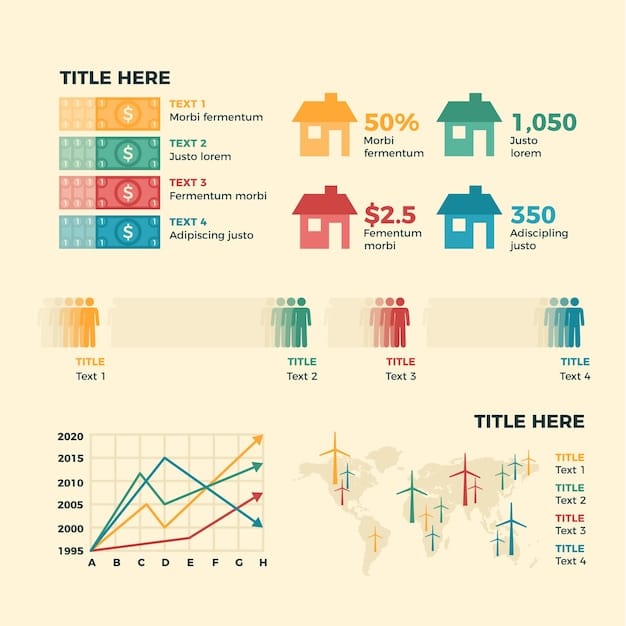Social Security Boost: 3.1% Benefit Increase Coming in January 2026

Alert: Social Security benefits are projected to increase by 3.1% in January 2026, according to recent estimates, offering financial relief to millions of Americans.
Get ready for some good news! Recent projections indicate that Alert: Social Security Benefits Projected to Increase by 3.1% in January 2026. This boost aims to help beneficiaries keep pace with rising living costs, ensuring a more secure financial future.
Understanding the Projected 3.1% Increase in Social Security Benefits
The anticipated 3.1% increase in Social Security benefits is a significant development for retirees, disabled individuals, and other beneficiaries. This adjustment, projected for January 2026, is designed to help offset the effects of inflation, ensuring that Social Security payments maintain their purchasing power. Let’s delve into the details of what this increase means for you.
How is the Cost-of-Living Adjustment (COLA) Calculated?
The annual Cost-of-Living Adjustment, or COLA, is calculated based on the Consumer Price Index for Urban Wage Earners and Clerical Workers (CPI-W). This index measures the average change over time in the prices paid by urban wage earners and clerical workers for a basket of goods and services. The Social Security Administration uses the CPI-W to determine how much benefits should be increased each year to keep pace with inflation.
Specifically, the COLA is based on the percentage increase in the CPI-W from the third quarter of the previous year to the third quarter of the current year. If the CPI-W increases, Social Security benefits are adjusted upward by the same percentage. This ensures that beneficiaries can afford the same goods and services, even as prices rise.
Factors Influencing the 2026 COLA Projection
Several economic factors influence the COLA projection for 2026. Inflation rates, economic growth, and government policies all play a role in determining the ultimate adjustment. The current projection of 3.1% reflects expectations about these factors, based on data available in mid-2024. However, it’s important to remember that economic conditions can change, and the actual COLA could be different.
- Inflation Rates: Higher inflation generally leads to a larger COLA.
- Economic Growth: Strong economic growth can sometimes moderate inflation, leading to a smaller COLA.
- Government Policies: Changes in government policies, such as tax laws or spending programs, can also influence inflation and the COLA.
In conclusion, the projected 3.1% increase in Social Security benefits for 2026 is the result of a complex calculation based on the CPI-W and influenced by various economic factors. While the projection is based on current data, it’s subject to change as economic conditions evolve.
Who Will Benefit from the Social Security Increase?
The projected 3.1% increase in Social Security benefits will affect a wide range of individuals. From retirees to disabled workers and their families, many Americans rely on Social Security to help meet their basic needs. Understanding who will benefit from this increase is crucial for planning and financial security.

The primary beneficiaries of the Social Security increase are:
- Retirees: Millions of retired workers receive Social Security benefits each month. The 3.1% increase will provide a much-needed boost to their income, helping them afford necessities like food, housing, and healthcare.
- Disabled Workers: Individuals who are unable to work due to a disability also receive Social Security benefits. The increase will help them cope with the added expenses often associated with disabilities, such as medical bills and specialized care.
- Dependents and Survivors: Social Security also provides benefits to dependents of retired or disabled workers, as well as survivors of deceased workers. These benefits will also increase by 3.1%, providing added financial support to families in need.
Impact on Different Age Groups
The Social Security increase will have a different impact on various age groups. Younger beneficiaries, such as disabled workers and dependents, may see a more significant improvement in their financial stability. Older retirees, who may have fixed incomes, will also benefit from the added income, helping them maintain their standard of living.
Geographic Distribution of Benefits
The benefits of the Social Security increase will be distributed across the country, with some states and regions seeing a greater impact than others. Areas with a higher concentration of retirees or disabled individuals will likely experience a more significant economic boost from the increased benefits. This can help support local economies and improve the overall well-being of communities.
In summary, the projected 3.1% increase in Social Security benefits will provide much-needed financial relief to retirees, disabled workers, dependents, and survivors across the United States. The impact will vary depending on age, geographic location, and individual circumstances, but overall, it represents a positive step toward ensuring financial security for millions of Americans.
Potential Challenges and Considerations
While the projected 3.1% increase in Social Security benefits is generally positive, it’s important to consider potential challenges and limitations. Inflation, healthcare costs, and the long-term solvency of Social Security are all factors that could affect the real-world impact of the increase.
Inflation and Purchasing Power
Even with a 3.1% increase, inflation could still erode the purchasing power of Social Security benefits. If the cost of goods and services rises faster than the benefit increase, beneficiaries may find it difficult to maintain their current standard of living. Monitoring inflation rates and adjusting benefits accordingly is crucial to ensuring that Social Security remains effective.
Healthcare Costs
Healthcare costs are a major concern for many Social Security beneficiaries, particularly older adults. Even a modest increase in healthcare expenses can offset the benefits of a 3.1% increase in Social Security payments. Policymakers need to address the rising cost of healthcare to ensure that beneficiaries can afford the medical care they need.
Long-Term Solvency of Social Security
The long-term solvency of Social Security is an ongoing concern. As the population ages and more people retire, the system faces increasing financial pressures. While the 3.1% increase provides a short-term boost, it’s important to address the long-term challenges facing Social Security to ensure that future generations can continue to rely on these benefits.
- Demographic shifts: An aging population and declining birth rates are putting strain on the Social Security system.
- Economic downturns: Recessions and economic slowdowns can reduce the amount of payroll taxes collected, further threatening the system’s solvency.
- Political factors: Debates over how to reform Social Security can lead to uncertainty and delay needed changes.
In conclusion, while the projected 3.1% increase in Social Security benefits is a welcome development, it’s important to consider potential challenges and limitations. Inflation, healthcare costs, and the long-term solvency of Social Security all need to be addressed to ensure that beneficiaries can truly benefit from the increase and maintain their financial security.
Expert Opinions and Analysis
To provide a comprehensive understanding of the projected 3.1% increase in Social Security benefits, it’s important to consider the opinions and analysis of experts in the field. Economists, financial advisors, and policy analysts offer valuable insights into the potential impact of the increase and its implications for Social Security beneficiaries.
According to many economists, the 3.1% increase is a positive step toward helping Social Security recipients keep pace with inflation. However, some experts caution that the increase may not be enough to fully offset the rising cost of living, particularly for those with fixed incomes. They recommend that beneficiaries carefully manage their finances and explore additional sources of income, if possible.
Perspectives from Financial Advisors
Financial advisors often advise Social Security recipients to consider the increase as part of their overall retirement planning. They suggest reviewing their budgets, reassessing their investment strategies, and exploring ways to reduce their expenses. Some advisors also recommend consulting with a financial professional to develop a personalized plan that takes into account their individual circumstances.
Policy Analysts’ Views

Policy analysts emphasize the importance of addressing the long-term solvency of Social Security. They argue that the 3.1% increase, while helpful in the short term, does not solve the underlying financial challenges facing the system. Many analysts support reforms that would strengthen Social Security for future generations, such as raising the retirement age or increasing payroll taxes.
- Long-term solutions: Experts suggest exploring options such as adjusting the retirement age, increasing payroll taxes, or modifying the benefit formula.
- Political consensus: Finding common ground among policymakers is essential to enacting meaningful reforms to Social Security.
- Public awareness: Educating the public about the challenges facing Social Security can help build support for necessary changes.
In summary, expert opinions and analysis provide valuable insights into the projected 3.1% increase in Social Security benefits. While the increase is generally viewed as positive, experts caution that it may not be enough to fully offset the rising cost of living and that long-term reforms are needed to ensure the solvency of Social Security.
Strategies for Maximizing Social Security Benefits
While the projected 3.1% increase in Social Security benefits is good news, it’s important for beneficiaries to take steps to maximize their benefits. There are several strategies that individuals can use to increase their monthly payments and ensure a more secure financial future. These strategies include delaying retirement, coordinating benefits with a spouse, and understanding the rules for claiming Social Security.
Delaying Retirement
Delaying retirement is one of the most effective ways to increase Social Security benefits. For each year that you delay claiming benefits beyond your full retirement age (up to age 70), your monthly payments will increase by a certain percentage. This can result in a significantly higher monthly payment over the course of your retirement.
Coordinating Benefits with a Spouse
Married couples have several options for coordinating their Social Security benefits. One strategy is for the higher-earning spouse to delay claiming benefits, while the lower-earning spouse claims benefits at their full retirement age. This can maximize the total benefits received by the couple over their lifetimes.
Understanding the Rules for Claiming Social Security
It’s important to understand the rules for claiming Social Security benefits. For example, claiming benefits before your full retirement age will result in a reduced monthly payment. Additionally, certain types of income, such as earnings from work, can affect your Social Security benefits if you claim them before your full retirement age.
Maximizing Social Security benefits requires careful planning and consideration of individual circumstances. By delaying retirement, coordinating benefits with a spouse, and understanding the rules for claiming Social Security, beneficiaries can increase their monthly payments and ensure a more secure financial future. Consulting with a financial advisor can also help individuals develop a personalized strategy for maximizing their Social Security benefits.
Steps to Take Now to Prepare for the Benefit Increase
With the projected 3.1% increase in Social Security benefits on the horizon, it’s important to take steps now to prepare for the change. This includes reviewing your budget, reassessing your financial goals, and exploring ways to supplement your income. Taking these steps can help you make the most of the benefit increase and ensure a more secure financial future.
Reviewing Your Budget
The first step in preparing for the benefit increase is to review your budget. This involves tracking your income and expenses to see where your money is going. Identifying areas where you can cut back can help you free up more money to save or invest.
Reassessing Your Financial Goals
The benefit increase is also a good time to reassess your financial goals. This includes setting new goals for retirement savings, paying off debt, or making other investments. Having clear financial goals can help you stay motivated and focused on your financial future.
Exploring Ways to Supplement Your Income
Finally, consider exploring ways to supplement your income. This could involve working part-time, starting a side business, or investing in assets that generate income. Supplementing your income can provide added financial security and help you achieve your financial goals.
Preparing Your Finances for the Social Security Increase
- Budgeting: Create a budget to track income and expenses, identifying areas for potential savings.
- Financial goals: Set clear, actionable financial goals to guide your savings and investments.
- Investing: Consider investing in diverse assets to generate income and grow your wealth.
In conclusion, preparing for the projected 3.1% increase in Social Security benefits involves reviewing your budget, reassessing your financial goals, and exploring ways to supplement your income. Taking these steps can help you make the most of the benefit increase and ensure a more secure financial future. Consulting with a financial advisor can also help you develop a personalized plan for achieving your financial goals.
| Key Point | Brief Description |
|---|---|
| 💰 3.1% Increase | Projected Social Security benefit increase in Jan 2026 |
| 👵 Beneficiaries | Retirees, disabled workers, and their families will benefit. |
| 📈 COLA | Based on the Consumer Price Index (CPI-W). |
| 💼 Strategies | Maximize benefits by delaying retirement and coordinating with spouse. |
Frequently Asked Questions
▼
The projected 3.1% increase in Social Security benefits is scheduled to take effect in January 2026. This adjustment will be reflected in the monthly payments received by beneficiaries.
▼
The Social Security Cost-of-Living Adjustment (COLA) is calculated based on the Consumer Price Index for Urban Wage Earners and Clerical Workers (CPI-W). It measures inflation.
▼
The Social Security increase is applicable to retirees, disabled people, and also the family members of those individuals who are covered by social security.
▼
Yes, you can amplify your Social Security benefits by delaying benefits, coordinating spousal benefits, and knowing the Social Security claiming guidelines.
▼
To prepare for the increase, it is important to review your expenses, to assess financial goals, and discover diverse avenues for added security to your financial state.
Conclusion
The projected 3.1% increase in Social Security benefits for January 2026 represents a positive development for millions of Americans. While the increase is designed to help offset the effects of inflation, it’s important for beneficiaries to take steps to maximize their benefits and ensure a more secure financial future. By understanding the COLA calculation, exploring strategies for maximizing benefits, and preparing for the change, individuals can make the most of this increase and improve their overall financial well-being.





